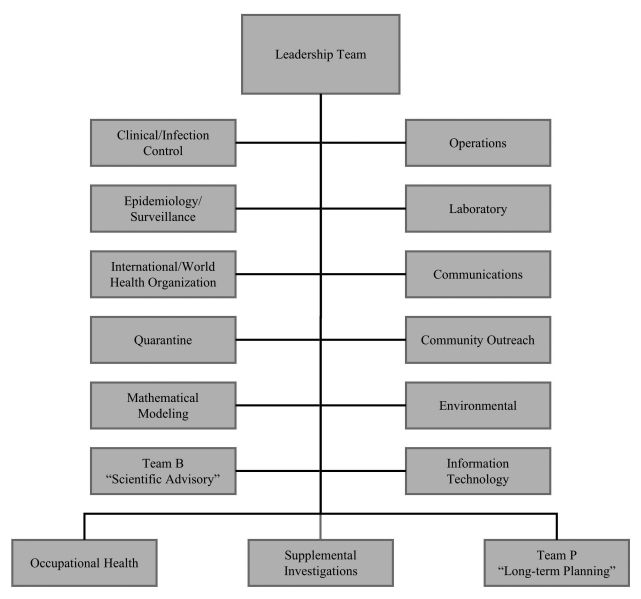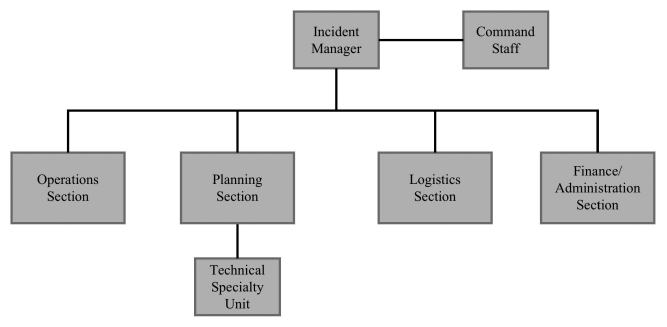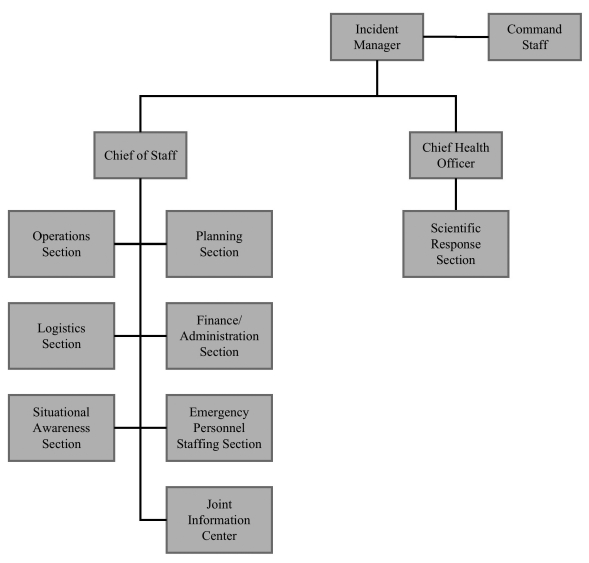Abstract
The organization of the response to infectious disease outbreaks by public health agencies at the federal, state, and local levels has historically been based on traditional public health functions (e.g., epidemiology, surveillance, laboratory, infection control, and health communications). Federal guidance has established a framework for the management of domestic incidents, including public health emergencies. Therefore, public health agencies have had to find a way to incorporate traditional public health functions into the common response framework of the National Incident Management System. One solution is the development of a Science Section, containing public health functions, that is equivalent to the traditional incident command system sections. Public health agencies experiencing difficulties in developing incident management systems should consider the feasibility and suitability of creating a Science Section to allow a more seamless and effective coordination of a public health response, while remaining consistent with current federal guidance.
At the Centers for Disease Control and Prevention (CDC), the response to public health emergencies, including infectious disease outbreaks, has historically been organized according to traditional public health functions, such as epidemiology, surveillance, laboratory, infection control, and health communications. Guidance from the Department of Homeland Security1 and directives from the White House (e.g., Homeland Security Presidential Directives)2,3 have established an approach for organizing and managing emergency responses through a common framework, the National Incident Management System (NIMS). As a result, CDC and other public health agencies are adapting their emergency response operations to comply with this guidance and improve their response to infectious disease outbreaks and other public health emergencies. The integration of public health response functions with the principles of emergency management (i.e., NIMS) requires a balanced approach. Although public health must abide by the response architecture outlined in NIMS, it is important to ensure that the implementation of a common framework enhances, rather than encumbers, the ability of public health practitioners to perform traditional public health response activities.
In response to the federal guidance, CDC developed a compatible incident management system (IMS) to manage the agency's response to public health emergencies. However, this organizational structure was difficult to implement because traditional public health response functions are not easily located within an IMS based on the principles of the Incident Command System (ICS). We describe CDC's challenges and solutions for including traditional public health response functions within the management structure. This discussion may assist other public health agencies that are struggling to identify and incorporate traditional public health functions within an incident management structure, based on current federal guidance.
PRE-IMS: A TEAM APPROACH
In 2003, NIMS was being developed in an attempt to standardize the management of domestic incidents by creating a single, comprehensive IMS.2 At this time, CDC became involved with the public health response to the 2003 outbreak of severe acute respiratory syndrome (SARS). Because NIMS was still a draft document, the principles of ICS and incident management were not explicitly cited as the basis for establishing CDC's response structure during the SARS outbreak.4 Instead, Posid et al.4 noted that the 2003 SARS response used the “team” concept (Figure 1) to organize agency-wide response operations; the term “team” referred to a group of people with complementary skill sets assembled to address a specific public health issue or fulfill a specific mission. During the SARS outbreak, the size, composition, and duration of the scientific/technical teams (e.g., epidemiology/surveillance, quarantine, and clinical/infection control), as well as other supporting teams (e.g., operations and information technology), were determined by the outbreak's evolving characteristics. Although the titles and labels of these teams were modified based upon incident-specific circumstances, the traditional public health functions performed by these core scientific/technical teams were essential to the agency's response to the SARS outbreak.
Figure 1.
CDC organizational structure for the response to the 2003 SARS outbreak, using the team concepta
aThe term “team” refers to a group of people with complementary skill sets assembled to address a specific public health issue or fulfill a specific mission. During the SARS outbreak, the size, composition, and duration of the scientific/technical teams (e.g., epidemiology/surveillance, quarantine, and clinical/infection control), as well as other supporting teams (e.g., operations and information technology), were determined by the evolving characteristics of the outbreak.
CDC = Centers for Disease Control and Prevention
SARS = severe acute respiratory syndrome
Following the response to the SARS outbreak, Posid et al. highlighted lessons learned that, if adopted, might better prepare CDC to more efficiently respond to future infectious disease outbreaks. One of those lessons was to modify an incident management structure that would be applicable for the response to large-scale infectious disease outbreaks. The response to the 2003 SARS outbreak “marked the first use of a newly established emergency operations facility and staff specifically hired to assist and support the CDC's response to a public health emergency.”4 As a result, CDC needed to develop a better system for integrating traditional public health response functions with the newly created infrastructure and programs designed to coordinate agency preparedness and response. Following the response to the 2003 SARS outbreak, CDC began to transition away from the team concept for the organization of response activities. In its place, CDC developed and implemented an IMS, which was consistent with proposed federal guidance and, in theory, allowed for a scalable and flexible approach for managing all activities, including the traditional public health response functions, during the response to a public health emergency.
CDC IMS: INITIAL DEVELOPMENT
The response to a public health emergency, including infectious disease outbreaks, occurs at the state and local level. During a response, CDC assists state and local health authorities by providing scientific/technical guidance on agent- or event-specific issues or personnel to assist with field activities (e.g., case interviews or environmental sampling). Response activities may be program-centric (i.e., conducted within a single CDC program) or require the use of agency-wide resources. While many responses can be managed from within a CDC program, certain public health emergencies (e.g., Hurricane Katrina and 2009 H1N1 influenza) require an agency-wide response with a centralized management structure. For these agency-wide responses, CDC manages its response activities from a central location, the CDC Emergency Operations Center (EOC). The CDC EOC is designed to provide a focal point for coordinating and supporting staff, information, communication, and security issues associated with an agency-wide response. Once activated, the CDC EOC uses an IMS organized by ICS section (i.e., Operations, Planning, Logistics, and Finance/Administration) rather than discipline or emergency support function. The ICS model allows CDC to be consistent with the management structure used by the operations center at the Department of Health and Human Services. Additionally, an ICS-based management structure allows CDC personnel deployed to the field to be familiar with ICS concepts and principles, which are being used for on-scene response coordination at the state and local levels.
However, there are some challenges with organizing and managing a public health response according to the principles of emergency management. For example, although the response to an infectious disease outbreak is conducted in the field, the management or command of the investigation usually occurs at a centralized location. This centralization allows for the integration and coordination of multiple population-focused activities, which are based on traditional public health functions. Because the management of a public health incident occurs at a central location rather than in the field, the organization of response activities based on the principles and practices of on-scene incident command may be difficult to implement. For example, which ICS section should contain the traditional public health functions? Because the public health response involves both elements of operations and planning, initial attempts were made to split the management of the scientific and technical teams between the Operations and Planning Sections. Although this division may have been consistent with the principles of ICS, it could not effectively manage the public health functions. Because public health operations and planning activities are intertwined, it became difficult for CDC responders to separate the team activities between the two sections. Adding to this confusion, the same name (e.g., epidemiology) was used to identify the teams in both the Operations and Planning Sections, which resulted in confusion and redundancies related to information flow through the CDC IMS. Therefore, an alternate approach was required to manage the public health functions within the CDC IMS.
CDC IMS: TECHNICAL SPECIALTY UNIT
In 2005, CDC implemented a revised all-hazard IMS structure (Figure 2) that was based on the agency's lessons learned from the response to the 2005 hurricane season, which included hurricanes Katrina, Rita, and Wilma. This version of the CDC IMS still comprised four sections (Operations, Planning, Logistics, and Finance/Administration) and included numerous command staff positions. The Incident Manager position and other senior response leadership positions were staffed by subject-matter experts (SMEs) at CDC. Personnel from throughout the agency comprised the various technical and general staff positions. The scientific and technical teams, which still served as the foundation of the agency's response to a public health emergency, were organized into a unit within the Planning Section. This unit, called the Technical Specialty Unit (TSU), was responsible for coordinating the activities associated with a public health response. The rationale for locating the TSU within the Planning Section was the need to link the public health response activities with the Incident Action Plan (IAP). Because the IAP captures the current and future activities of a response, associating the TSU with the Planning Section, which is responsible for developing the IAP, was thought to be beneficial. However, organizing and implementing a public health response on the basis of the TSU model also proved to be difficult.
Figure 2.
All-hazards CDC incident management system organizational structure, using a Technical Specialty Unit, based on lessons learned from the response to the 2005 hurricane season
CDC = Centers for Disease Control and Prevention
Although the TSU was responsible for collecting and analyzing situational data for use in determining CDC's course of action, it was also responsible for coordinating and interacting with assets deployed in the field, developing scientifically accurate public health guidance, and working with partners to implement specific programs or strategies (e.g., sentinel surveillance and medical countermeasure distribution) to respond to the event. Therefore, the TSU was a hybrid of functions normally contained within the Operations and Planning Sections, making it difficult to solely locate the TSU within a single ICS section. This problem became more apparent as SMEs, who normally conduct infectious disease outbreak investigations as part of their daily duties, were unable to clearly understand their place or role in the CDC IMS. Despite these difficulties, this version of the CDC IMS remained as the agency's model for the response to public health emergencies until the 2009 H1N1 influenza pandemic.
CDC IMS: TASK FORCES
“On April 17, 2009, CDC determined that two cases of febrile respiratory illness, occurring in children who resided in adjacent counties in southern California, were caused by infection with a novel swine influenza A (H1N1) virus.”5 In response to this report, the acting CDC director activated the CDC EOC to support the management of the ongoing influenza investigation. The CDC IMS used at the beginning of the response to 2009 H1N1 influenza was based on the TSU model. The traditional public health functions associated with an infectious disease response were located in the TSU and included most subject-matter expertise during the response. However, after the initial wave of 2009 H1N1 influenza subsided in early June, CDC IMS leadership determined that it needed to modify the incident management structure to better organize and manage the needs of the response. Because the scientific/technical teams were the foundation of CDC's public health response to the pandemic, experience suggested that they should not be located within one of the traditional ICS sections. The CDC IMS leadership determined that the scientific/technical teams should be located in their own section alongside the other ICS functions.
The modified CDC IMS structure was implemented in the fall of 2009, when the structure was modified by removing the TSU from the Planning Section. In its place, CDC created five task forces that addressed specific areas of the influenza response: Epidemiology/Laboratory, Community Mitigation, Vaccine, Medical Care and Countermeasures, and State Coordination, all of which reported directly to the Incident Manager (Figure 3). Although not officially identified as a section, these task forces effectively constituted a science section. These task forces, led by SMEs, were responsible for conducting and coordinating the traditional public health activities associated with the response to an infectious disease outbreak. Because the task forces reported directly to the Incident Manager, response leadership possessed greater oversight and management of the scientific/technical issues. This version (task force) of the CDC IMS remained as the organizational structure for the response from fall 2009 until 2009 H1N1 response operations ended in May 2010.
Figure 3.
CDC incident management system structure for the response to 2009 H1N1 influenza, modified to include task forces
CDC = Centers for Disease Control and Prevention
CDC IMS: CREATION OF A SCIENCE SECTION
Using the response to 2009 H1N1 influenza as a model, CDC has further adapted its all-hazards IMS structure by creating a Science Section that is responsible for conducting and coordinating the public health activities associated with a response (Figure 4). Also known as the Scientific Response Section, this section reports directly to the Incident Manager or Chief Health Officer, which is staffed by a senior scientist or medical officer who is an SME. The creation of a separate Science Section is consistent with a reference for the creation of an Intelligence/Investigations function, mentioned in the December 2008 version of NIMS. According to NIMS, this function may be necessary “for the collection, analysis, and sharing of information developed during intelligence/investigation efforts.”1 This information includes data (e.g., agent, source, and countermeasures) gathered as part of the public health investigation for a disease outbreak. Furthermore, NIMS indicates that this Intelligence/Investigations function can be located in several places within the incident command/management structure, including being its own section.1 Therefore, the creation of a new section devoted to scientific/technical issues is in compliance with current NIMS guidance. By creating a separate section devoted to addressing scientific/technical issues, the activities traditionally conducted by public health are more easily integrated into the concept of emergency management and align with the traditional sections of ICS, which serve in an equal but primarily supportive role to the scientific investigation.
Figure 4.
Current all-hazards CDC incident management system structure, incorporating a Science Section
CDC = Centers for Disease Control and Prevention
The creation of a Science Section takes advantage of the ICS principles (flexibility, scalability, and adaptability) and elevates the traditional public health response team concept, which was used by CDC in previous events, to a more prominent role in CDC's IMS. This change allows the Incident Manager to have increased visibility and awareness of the public health activities, which serve as the foundation of CDC's response to an infectious disease outbreak, yet had previously been overshadowed within the CDC IMS structure. Additionally, creating a Science Section may enable public health personnel to more easily adapt to operating within an IMS because they can easily identify their role and function within the structure (i.e., it is consistent and compatible with the activities and functions normally conducted within their program).
Even though the revised CDC IMS structure with a Science Section was developed during the response to an infectious disease outbreak, it was implemented for several recent public health emergencies that were not related to infectious diseases (e.g., Haiti Earthquake and Deepwater Horizon Oil Spill). Currently, this model of the CDC IMS with a Science Section serves as CDC's all-hazard model for the response to public health emergencies.
CONCLUSIONS
Since the CDC IMS was created, a major challenge has been incorporating the traditional public health functions within a structure that is consistent with NIMS and based on the principles of ICS. Over time, CDC developed an IMS that incorporates a Science Section in conjunction with the traditional ICS sections. Locating the public health functions within their own section enables agency and/or response leadership to have increased access to and awareness of public health activities, which serve as the foundation of CDC's response to an infectious disease outbreak or other public health emergency. Additionally, it may allow for greater familiarity and ease of use of an IMS by public health responders because they can readily identify the location of their roles/functions within the structure. Although there are differences between CDC and other public health agencies at the federal, state, local, and international level, those agencies that are experiencing difficulties in developing IMSs may want to consider creating a similar science section within their structure to allow for more effective coordination of the public health response.
Overall, public health needs to better integrate traditional public health practice and functions with the principles of emergency management. Recent changes to NIMS allow public health greater flexibility in organizing and managing response activities while still maintaining compliance with current federal guidance. These changes allow public health to use NIMS/ICS to benefit the response instead of trying to adapt the public health response to NIMS/ICS.
REFERENCES
- 1.Department of Homeland Security (US), Federal Emergency Management Agency. National Incident Management System. Washington: Department of Homeland Security; 2008. Dec, [cited 2010 Apr 15]. Also available from: URL: http://www.fema.gov/pdf/emergency/nims/NIMS_core.pdf. [Google Scholar]
- 2.Department of Homeland Security (US). Homeland Security presidential directive 5: management of domestic incidents. 2003. [cited 2009 Apr 15]. Available from: URL: http://www.dhs.gov/xabout/laws/gc_1214592333605.shtm.
- 3.Department of Homeland Security (US). Presidential policy directive/PPD-8: national preparedness. 2011. [cited 2011 Nov 21]. Available from: URL: http://www.dhs.gov/xabout/laws/gc_1215444247124.shtm.
- 4.Posid JM, Bruce SM, Guarnizo JT, Taylor ML, Garza BW. SARS: mobilizing and maintaining a public health emergency response. J Public Health Manag Pract. 2005;11:208–15. doi: 10.1097/00124784-200505000-00005. [DOI] [PubMed] [Google Scholar]
- 5.Swine influenza A (H1N1) infection in two children—Southern California, March-April 2009. MMWR Morb Mortal Wkly Rep. 2009;58(15):400–2. [PubMed] [Google Scholar]






